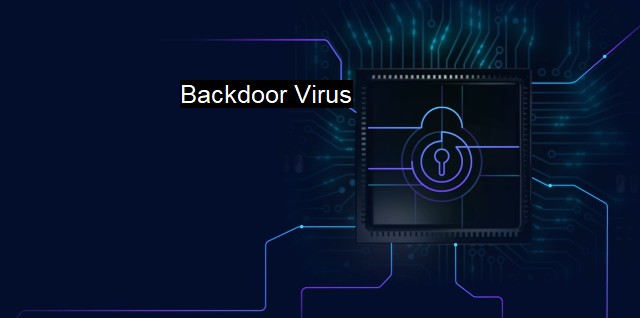What are Backdoor Virus?
The stealthy threat of backdoor viruses: How cybercriminals use hidden entrances to breach computer systems and compromise security
A "Backdoor Virus" is a form of malicious software, or malware, categorized under cybersecurity threats. The name itself is a fitting description of what it does. Much like a thief who uses a hidden or unknown entrance to gain unauthorized access to a house, a backdoor virus secretly slips past security protocols and infiltrates a computer system without the user's knowledge. This malicious 'backdoor' into systems is used to bypass normal authentication processes to result in potential illegal or illicit activities.After a successful breach, the backdoor virus establishes command, control, and it maintains access despite other security measures in place. The backdoor's mission is to allow unauthorized remote control over the infected device by a malicious actor, providing unlimited access to data, network resources, communication flow, and user interaction. These viruses can exploit system vulnerabilities for various malicious intentions like data theft, system damage, interruption of services, and a multitude of other cybersecurity threats.
The most significant aspect of a backdoor virus is its stealth. It is typically challenging to recognize, remove, or quarantine since it can mimic regular files or applications. They are cleverly engineered to mislead the system's antivirus software. These disguised features enable the virus to operate unnoticed and avoid triggering any alerts.
Backdoor viruses are a significant threat in the cyber landscape due to the extent of their actions. One type, known as a RAT (Remote Access Trojan), not only provides the wrongdoer with complete control, but it also permits recording user activity, enabling a deeper level of cyber-espionage. Another variant involves botnets, a series of interconnected devices, infected to launch massive attacks like spam or denial-of-service actions to other networks, applications, or websites.
Containment and protection from backdoor viruses are multi-tiered and bite beyond standard antivirus software. Firstly, always keep systems and applications up-to-date with the manufacturer's sanctioned patches and updates. Software often has vulnerabilities that viruses can exploit. When discovered, manufacturers will typically develop and distribute an update to close the vulnerability - a crucial point of maintaining security.
Nonetheless, protective measures do not stop and start with software updates, as they should seamlessly blend with robust antivirus software. A reliable antivirus program should include real-time scanning and detection of known threats, advanced threat detection functionality that can identify and isolate newly identified viral threats, and comprehensive system scanning capabilities.
Taking caution with emails from unfamiliar senders or unexpected emails from known contacts proves very beneficial as well. Often, these could contain potential malware downloads, including backdoor viruses, discreetly concealed in attachments or embedded links. Exploring unsolicited emails with caution contributes significantly to a comprehensive security approach.
Additional measures involve restriction of administrative privileges to necessary cases only, granulated access controls, encryption of sensitive data, periodical reinforcement of password regimens, and secure backup and recovery protocols.
Regular testing and examination of perimeter security measures to proactively seek out possible breach points are also essential. By continuously mapping out and hardening existing and potential weak links from unauthorized manipulation, it becomes harder for any malware, including backdoor viruses, to find and exploit vulnerabilities.
Backdoor viruses are aptly named covert security threats that infiltrate unnoticed to enable insider manipulation for explicit harm. These threats may exploit system vulnerabilities by bypassing normal checks and systems to result in various damaging outcomes. Following cybersecurity best practices and utilizing comprehensive antivirus solutions are essential for preventing, identifying, and mitigating these risks. Keeping the protective measures active and updated plays a significant role in a strategic and collective defense model that adapts continually in an increasingly threat-filled digital world.

Backdoor Virus FAQs
What is a backdoor virus?
A backdoor virus is a type of malicious software that creates a secret entry point, also known as a backdoor, in a computer system. This can allow cybercriminals to gain unauthorized access to the system and steal sensitive data, install more malware or take control of the system.How does a backdoor virus infect a computer system?
Backdoor viruses can infect a computer through various means, including downloading infected email attachments or software, clicking on malicious links or pop-ups, or exploiting system vulnerabilities. They can also spread through networks, removable storage devices or file sharing.What are the signs of a backdoor virus infection?
Some common signs of a backdoor virus infection include slow system performance, sudden pop-ups, unexplained changes to system settings, disabled antivirus or firewall protection, and unauthorized account access.How can I protect my computer from backdoor viruses?
To protect your computer from backdoor viruses, you should ensure that you have updated antivirus and firewall software installed. You should also be careful when downloading software or opening email attachments, and avoid clicking on suspicious-looking links or pop-ups. Regularly backing up important data and using multi-factor authentication for sensitive accounts can also provide an additional layer of protection.| | A | | | B | | | C | | | D | | | E | | | F | | | G | | | H | | | I | | | J | | | K | | | L | | | M | |
| | N | | | O | | | P | | | Q | | | R | | | S | | | T | | | U | | | V | | | W | | | X | | | Y | | | Z | |
| | 1 | | | 2 | | | 3 | | | 4 | | | 7 | | | 8 | | |||||||